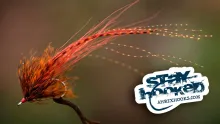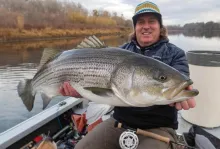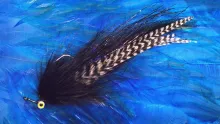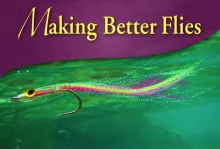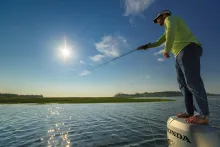This small book has made me a striper fan. The subtitle gave me the first hint that this would be interesting
Updated or edited 8 months ago
Fri, 23 Jun 1995 09:53:09 +0100 (MET)
Hi book and flyfishing lovers
It's time again. Another of those Danish book reviews. This small book has been mentioned on several occasions before, and I have succeeded in getting it -- thanks to a much valued member of the FLYFISH@ list. The book is:
J.Kenney Abrames: Striper Moon
Published by Frank Amato Publications, Portland OR, USA, 1994
ISBN 1-878175-67-X
Price: US$ 15.95
"What's that?" I can hear you say. "Why does this guy want to read a book on stripers...?". Everybody knows (well maybe not everybody) that there are no striped bass in Denmark and a lot of you guys know that I fish almost exclusively for sea trout in salt. So why be so interested in a book on this particular kind of fishing?
Well... Curiosity is one good reason. I've always been curious about this particular fish and the hunt for it. I've read lots of magazine articles about it, seen lots of pictures and heard it praised as a fish worth going for, but never really precisely understood what it is, where to catch it, with what and so on.
I do now. This small book has made me a striper fan. The subtitle gave me the first hint that this would be interesting: 'Fly Fishing Techniques and Flies for Striped Bass in Estuary, River, Bay and Surf'. Being a salt water FF'er myself, any FF-title, that doesn't include the word 'stream' is interesting. Estuary, River Bay and Surf. I fish almost exclusively in bay and surf, and this kind of fishing seems little known elsewhere. In the forword by Lefty Kreh it even says
"Ken [the author] is happiest with his feet planted in the sand... surf rolling... his fly into the darkness...".
This sounds exactly like my kind of fishing -- wading from the coast at night.
I mentioned that it's a small book. It is. It's not much thicker than a magazine and the page count is just a bit more than 50. It's a fairly large format, but still a small book.
I'm a bit of an aestethic freak, and my first reaction to the book was not positive. It uses a typograhy that I personally don't like very much and uses a green color for headings and frames, that don't really seem in harmony with the blue moon' and the low color mood that is characteristic of the text and pictures.
Lukcily there are elements that fight this happy-color green. First of all the authors oil paintings which catch both the calm meditation and the dynamics of his fishing. Second, but at least equally important, there are lots of beautiful photographs -- mostly of locations but also of people and fish. Both oils and photos add a lot to the book.
But there is no doubt that the text is the centerpiece -- how ever short it might be. This is one of the most quotable texts I've ever read on fishing, and I'll set the tone by quoting the first sentence:
"When I was quite young, barely out of daipers, I discovered that I was and always would be a fisherman"
The author manages to get this message and many others across to the reader in a way that you really believe and that don't give you a taste of neither sentimentality or patronizing attitudes.
The facts in this book are few. It is a small book, and there are just as many stories and anecdotes as there are facts.
But... Ken Abrames' way of doing things is obviously different. He refers to greased line fishing (as in fishing for summer salmon), slack line techniques (dead drift) and the classic wet fly swing as known from streams. We're still talking mostly salt water fishing here, and it's a real pleassure to get these new angles.
Sometimes the author deals with the facts in an extremely brief manner. Night fishing:
"If you want to catch stripers, fish at night".
That's it! The section on night fishing is 10 lines! OK, all is said, but a bit more on technique and tactics would have been nice.
On the other hand Ken Abrames deals with factors that I personally find of great importance, but never before saw mentioned in those sunshine-from-a- clear-blue-sky-in-the-middle-of-the-day-always-in-shorts-articles from the glossy US magazines.
Factors that are alfa and omega to my own fishing (sea trout in salt) like wind, current and tide get more attention than the night fishing. My guess is that many traditional striper fishers or other kind of salt fishers for that matter, could learn a lot here. There's more to it than slinging that line out into the ocean from a boat on a calm sunny day.
The last section in the book is on tackle: flies and rod/reel/lines. The author has a very nice attitude when it comes to tying flies (much in line with my own), and here I have to quote again:
"I seldom tie the same fly twice. I believe this is how it should be. The ocean is dynamic and so are the creatures who live in it".
True of much of my own tying and fishing.
This is a higly inspiring book, and even though I never fished a striper, and most likely won't in the near future, I found many good ideas for methods and flies, that I intend to use in my own fishing. I believe that many other fishers -- including stream fishers -- would gain from the wisdom in this small book.
One last quote: "Study atlantic salmon fly tying and most of your [fly tying]problems will disappear". That's exactly what I've been doing, and my next review will be on Pryce-Tannats 'How to Dres Salmon Flies'.
See you there.
- Log in to post comments

